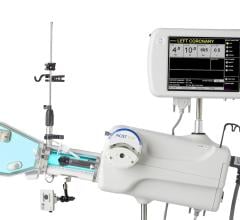
Medrads Avanta power contrast injection system. Power injectors allow smaller 4 French catheters to be used when performing radial access procedures.
Radial artery occlusion rate during transradial access procedures is strongly related to sheath and catheter size. Although worldwide most experienced practitioners (90 percent) use 5 and 6 French systems(1), high-quality coronary artery opacification can be obtained with 4 French systems. However, high-flow states (arteriovenous [AV] fistulae in hemodialysis patients), large coronaries encountered in non-ischemic cardiomyopathy or cold, high-viscosity contrast media frequently impact image quality.
Currently, there are two power contrast injection systems specifically designed for use in the cardiac catheterization laboratories: Medrad’s Avanta and the Acist CVi. Many cardiac catheterization laboratories use these systems, since they provide reliable injection rates and optimal coronary opacification using smaller French systems.
These devices are usually table-mounted and have sufficient contrast storage to allow performance of several procedures during a regular day. This significantly reduces contrast waste between procedures. The “multi-patient” disposable part is then attached to the single-patient disposable unit. Compared to the well-known but bulky traditional manifolds frequently seen in cardiac catheterization laboratories, these systems are quite nimble. Once the tubing from the power injector is attached to the coronary catheter, the operator only needs to hold the hand controller unit. This is not trivial, since it allows increased distance from the radiation source and significantly reduces radiation exposure to the operator. Another very tangible benefit is the seamless transition from injection to pressure tracing – since there is no manifold, there are no stopcocks to turn.
Published studies support the use of these devices and show contrast volume is consistently reduced and equivalent vessel opacification can be achieved.(2) When comparing 6 and 4 French systems, one study found no difference in image quality and less contrast use with the 4 French system.(3) Despite these advantages, only a minority of operators currently use 4 French systems.
In our opinion, since radial artery occlusion rates are associated with catheter size, we recommend using the smallest catheter necessary to obtain optimal coronary opacification. “Down-sizing” diagnostic catheters goes hand in hand with “right-sizing” interventional equipment. A large percentage of percutaneous coronary interventions can be performed with 5 French guiding catheters, and power injectors are exceptionally well suited for interventional use.
References:
1. Bertrand, O. F., S. V. Rao, et al. (2010). “Transradial approach for coronary angiography and interventions: results of the first international transradial practice survey.” JACC Cardiovascular Interventions, 2010, 3 (10): 1022-1031.
2. Chahoud, G., S. Khoukaz, et al. “Randomized comparison of coronary angiography using 4 French catheters: 4 French manual versus ‘Acisted’ power injection technique.” Catheterization and Cardiovascular Interventions, 2001, 53 (2): 221-224.
3. Hou, L., Y. D. Wei, et al. “Comparative study of 4 French catheters using the Acist variable rate injector system versus 6 French catheters using hand manifold in diagnostic coronary angiography via transradial approach.” Chinese Medical Journal (Engl), 2010, 123 (11): 1373-1376.




 January 11, 2024
January 11, 2024 




